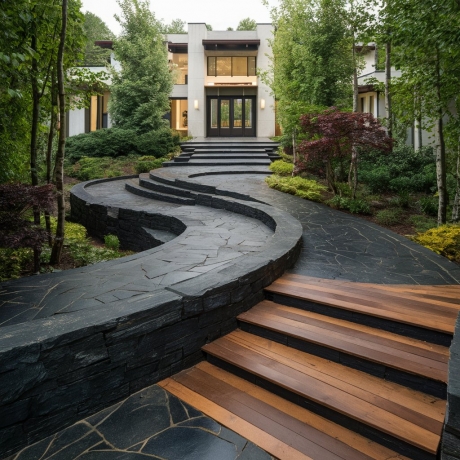The perfect style, materials, and design to create walkways and steps that are both beautiful and practical. Creating stunning walkways and steps is a fantastic way to elevate your curb appeal and enhance the overall beauty of your home. These features not only provide functional access to your home but also serve as a key design element that can make a lasting first impression.
Understanding the Impact of Walkways and Steps
Walkways and steps play a critical role in your home's exterior design. They guide visitors to your door, highlight the architecture of your home, and tie together different elements of your landscape. Choosing the right design can significantly impact your home's curb appeal, making it more inviting and visually appealing.
Aesthetic Enhancement
Walkways and steps should complement the style of your home. Whether your home has a modern, traditional, or rustic design, the right choice of materials and layout can enhance its overall aesthetic. A well-designed walkway or set of steps can highlight architectural details, create a sense of balance, and add a touch of elegance to your property.
Functionality and Safety
In addition to enhancing your home's appearance, walkways and steps provide essential functionality. They offer safe, easy access to different areas of your property, ensuring that you, your family, and visitors can move around comfortably. Properly designed steps prevent accidents, especially in areas with slopes or uneven terrain, while walkways guide people along the safest, most convenient routes.
Increasing Property Value
Investing in high-quality walkways and steps can increase the value of your home. Prospective buyers often look for homes with well-maintained and attractive outdoor spaces. A beautifully designed walkway or set of steps can be a major selling point, making your home more appealing to buyers and potentially increasing its market value.
Choosing the Right Materials
Selecting the right materials for your walkways and steps is crucial to achieving the desired look and functionality. Each material has its own set of benefits, and the best choice will depend on your home's style, budget, and maintenance preferences.
Natural Stone
Natural stone is a timeless and elegant choice for walkways and steps. Materials like bluestone, limestone, and slate offer a variety of colors and textures that can be tailored to match your home's aesthetic. Stone is durable and can withstand heavy foot traffic, making it ideal for both front and backyard paths. While it may be more expensive, the long-term durability and classic appeal of natural stone make it a worthwhile investment.
Concrete Pavers
Concrete pavers are a versatile and cost-effective option. Available in numerous shapes, sizes, and colors, pavers can be arranged in a variety of patterns to create a customized look. Concrete pavers are durable, easy to install, and can mimic the appearance of more expensive materials like brick or natural stone. They're an excellent choice for modern homes or those looking for a low-maintenance solution.
Brick
Brick walkways and steps exude a classic charm that's perfect for traditional or colonial-style homes. The warm, earthy tones of brick create a welcoming atmosphere, and the material is known for its durability. Brick can be laid in intricate patterns, such as herringbone or basketweave, to add visual interest. While brick requires minimal maintenance, occasional cleaning and sealing will help preserve its appearance.
Gravel
Gravel is an affordable and easy-to-install material that works well in informal or rustic settings. It's particularly suited for garden paths and areas with good drainage. Gravel paths can be edged with stone, metal, or wood to keep the material in place. Although gravel requires more upkeep to prevent weeds and maintain a tidy appearance, it offers a natural look that blends seamlessly with the landscape.
Wood
Wooden walkways and steps bring a natural, organic feel to your outdoor space. Treated wood or composite materials are recommended for durability and resistance to rot and insects. Wood is ideal for creating a warm, inviting atmosphere, especially in homes surrounded by trees or greenery. Regular maintenance, such as staining and sealing, is necessary to keep wood looking its best.
Designing Your Walkways and Steps
The design of your walkways and steps should reflect both your style and the architectural character of your home. Here are some key considerations to help you create a cohesive and attractive design:
Path Layout
The layout of your walkways should complement the flow of your property. Straight paths offer a formal, direct route and are well-suited for front entrances. In contrast, curved or winding paths create a more relaxed, natural feel, making them ideal for garden areas or larger landscapes. Consider how the path will be used and how it will connect different areas of your yard.
Step Design
Steps should be designed with both aesthetics and safety in mind. The width and depth of each step should be consistent to ensure safe footing. Wider steps create a grand entrance, while narrower steps are better for smaller spaces. The material and color of your steps should harmonize with your walkways to create a unified look. Consider adding handrails for extra safety, especially on longer or steeper staircases.
Edging and Borders
Edging your walkways and steps can add a polished look while keeping materials like gravel or mulch in place. Edging materials can range from brick and stone to metal or wood, depending on the style you want to achieve. Edging can also serve as a decorative element, offering a contrast in color or texture that enhances the overall design.
Lighting
Proper lighting is essential for both safety and ambiance. Solar-powered lights can be easily installed along the edges of your paths or steps to provide soft, energy-efficient illumination. Low-voltage lighting can be installed under steps or along railings to highlight the walking surface and prevent trips or falls. Lighting also adds a magical touch to your outdoor space, making it usable and inviting even after dark.
Maintenance Tips for Longevity
To ensure your walkways and steps remain beautiful and functional for years to come, regular maintenance is key. Here are some tips to help you keep them in top condition:
Regular Cleaning
Debris, dirt, and leaves can accumulate on your walkways and steps, leading to stains and slippery surfaces. Regularly sweep or hose down the area to keep it clean. For tougher stains, a mild detergent and scrub brush may be needed.
Weed Control
Weeds can grow between pavers or in gravel paths, detracting from the overall appearance. Applying a weed barrier during installation can help prevent this. For existing paths, use a weed killer or manually remove weeds as they appear.
Addressing Damage
Over time, weather and heavy use can cause wear and tear on your walkways and steps. Check regularly for cracks, shifting, or settling in pavers and repair as needed. Replace damaged materials promptly to maintain safety and aesthetics. Wooden steps may require periodic sealing or staining to protect against moisture and UV damage.
Walkways and Steps
Gorgeous walkways and steps can significantly elevate your home's curb appeal, making it more welcoming and visually appealing. Whether you prefer the timeless elegance of natural stone, the versatility of concrete pavers, or the classic charm of brick, choosing the right materials and design is crucial to achieving the desired look. By considering factors such as layout, materials, and maintenance, you can create walkways and steps that not only enhance your home's beauty but also offer safety and functionality.
For professional guidance and high-quality installation, Provision Paving and Masonry is your go-to partner. Their experienced team can help you design and build the perfect walkways and steps that will transform your outdoor space and boost your home's curb appeal.






